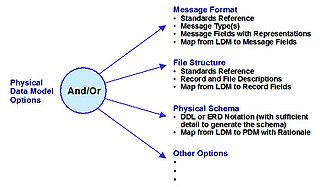
In computing, a database is an organized collection of data or a type of data store based on the use of a database management system (DBMS), the software that interacts with end users, applications, and the database itself to capture and analyze the data. The DBMS additionally encompasses the core facilities provided to administer the database. The sum total of the database, the DBMS and the associated applications can be referred to as a database system. Often the term "database" is also used loosely to refer to any of the DBMS, the database system or an application associated with the database.
A conceptual schema or conceptual data model is a high-level description of informational needs underlying the design of a database. It typically includes only the main concepts and the main relationships among them. Typically this is a first-cut model, with insufficient detail to build an actual database. This level describes the structure of the whole database for a group of users. The conceptual model is also known as the data model that can be used to describe the conceptual schema when a database system is implemented. It hides the internal details of physical storage and targets the description of entities, datatypes, relationships and constraints.

A data model is an abstract model that organizes elements of data and standardizes how they relate to one another and to the properties of real-world entities. For instance, a data model may specify that the data element representing a car be composed of a number of other elements which, in turn, represent the color and size of the car and define its owner.

The database schema is the structure of a database described in a formal language supported typically by a relational database management system (RDBMS). The term "schema" refers to the organization of data as a blueprint of how the database is constructed. The formal definition of a database schema is a set of formulas (sentences) called integrity constraints imposed on a database. These integrity constraints ensure compatibility between parts of the schema. All constraints are expressible in the same language. A database can be considered a structure in realization of the database language. The states of a created conceptual schema are transformed into an explicit mapping, the database schema. This describes how real-world entities are modeled in the database.
Any change in a computing system, such as a new feature or new component, is transparent if the system after change adheres to previous external interface as much as possible while changing its internal behaviour. The purpose is to shield from change all systems on the other end of the interface. Confusingly, the term refers to overall invisibility of the component, it does not refer to visibility of component's internals. The term transparent is widely used in computing marketing in substitution of the term invisible, since the term invisible has a bad connotation while the term transparent has a good connotation. The vast majority of the times, the term transparent is used in a misleading way to refer to the actual invisibility of a computing process, which is also described by the term opaque, especially with regards to data structures. Because of this misleading and counter-intuitive definition, modern computer literature tends to prefer use of "agnostic" over "transparent".
Codd's twelve rules are a set of thirteen rules proposed by Edgar F. Codd, a pioneer of the relational model for databases, designed to define what is required from a database management system in order for it to be considered relational, i.e., a relational database management system (RDBMS). They are sometimes referred to as "Codd's Twelve Commandments".

Data modeling in software engineering is the process of creating a data model for an information system by applying certain formal techniques. It may be applied as part of broader Model-driven engineering (MDE) concept.
Dataphor is an open-source truly-relational database management system (RDBMS) and its accompanying user interface technologies, which together are designed to provide highly declarative software application development. The Dataphor Server has its own storage engine or it can be a virtual, or federated, DBMS, meaning that it can utilize other database engines for storage.
A logical data model or logical schema is a data model of a specific problem domain expressed independently of a particular database management product or storage technology but in terms of data structures such as relational tables and columns, object-oriented classes, or XML tags. This is as opposed to a conceptual data model, which describes the semantics of an organization without reference to technology.

A physical data model is a representation of a data design as implemented, or intended to be implemented, in a database management system. In the lifecycle of a project it typically derives from a logical data model, though it may be reverse-engineered from a given database implementation. A complete physical data model will include all the database artifacts required to create relationships between tables or to achieve performance goals, such as indexes, constraint definitions, linking tables, partitioned tables or clusters. Analysts can usually use a physical data model to calculate storage estimates; it may include specific storage allocation details for a given database system.
Database design is the organization of data according to a database model. The designer determines what data must be stored and how the data elements interrelate. With this information, they can begin to fit the data to the database model. A database management system manages the data accordingly.
A federated database system (FDBS) is a type of meta-database management system (DBMS), which transparently maps multiple autonomous database systems into a single federated database. The constituent databases are interconnected via a computer network and may be geographically decentralized. Since the constituent database systems remain autonomous, a federated database system is a contrastable alternative to the task of merging several disparate databases. A federated database, or virtual database, is a composite of all constituent databases in a federated database system. There is no actual data integration in the constituent disparate databases as a result of data federation.
Object–relational impedance mismatch is a set of difficulties going between data in relational data stores and data in domain-driven object models. Relational Database Management Systems (RDBMS) is the standard method for storing data in a dedicated database, while object-orientated (OO) programming is the default method for business-centric design in programming languages. The problem lies in neither relational databases nor OO programming, but in the conceptual difficulty mapping between the two logic models. Both logical models are differently implementable using database servers, programming languages, design patterns, or other technologies. Issues range from application to enterprise scale, whenever stored relational data is used in domain-driven object models, and vice versa. Object-oriented data stores can trade this problem for other implementation difficulties.

Uniface is a low-code development and deployment platform for enterprise applications that can run in a large range of runtime environments, including mobile, mainframe, web, Service-oriented architecture (SOA), Windows, Java EE, and .NET. Uniface is used to create mission-critical applications.

Integration DEFinition for information modeling (IDEF1X) is a data modeling language for the development of semantic data models. IDEF1X is used to produce a graphical information model which represents the structure and semantics of information within an environment or system.

The ANSI-SPARC Architecture, is an abstract design standard for a database management system (DBMS), first proposed in 1975.

The three-schema approach, or three-schema concept, in software engineering is an approach to building information systems and systems information management that originated in the 1970s. It proposes three different views in systems development, with conceptual modelling being considered the key to achieving data integration.

A semantic data model (SDM) is a high-level semantics-based database description and structuring formalism for databases. This database model is designed to capture more of the meaning of an application environment than is possible with contemporary database models. An SDM specification describes a database in terms of the kinds of entities that exist in the application environment, the classifications and groupings of those entities, and the structural interconnections among them. SDM provides a collection of high-level modeling primitives to capture the semantics of an application environment. By accommodating derived information in a database structural specification, SDM allows the same information to be viewed in several ways; this makes it possible to directly accommodate the variety of needs and processing requirements typically present in database applications. The design of the present SDM is based on our experience in using a preliminary version of it. SDM is designed to enhance the effectiveness and usability of database systems. An SDM database description can serve as a formal specification and documentation tool for a database; it can provide a basis for supporting a variety of powerful user interface facilities, it can serve as a conceptual database model in the database design process; and, it can be used as the database model for a new kind of database management system.

NIST Enterprise Architecture Model is a late-1980s reference model for enterprise architecture. It defines an enterprise architecture by the interrelationship between an enterprise's business, information, and technology environments.
The following is provided as an overview of and topical guide to databases:










